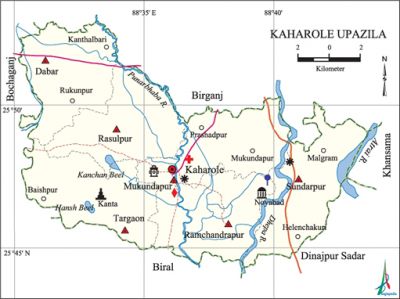Kaharole Upazila
Kaharole Upazila (dinajpur district) area 205.53 sq km, located in between 25°44' and 25°53' north latitudes and in between 88°30' and 89°43' east longitudes. It is bounded by birganj upazila on the north, dinajpur sadar and biral upazilas on south, khansama and Dinajpur Sadar upazilas on the east, bochaganj upazila on the west.
Population Total 154432; male 77253, female 77179; Muslim 83234, Hindu 68043, Christian 1240 and others 1915. Indigenous community such as santal belongs to this upazila.
Water bodies Main rivers: punarbhaba, atrai, Dhepa; Kanchan, Hansh beels are notable.
Administration Kaharole Thana was formed in 1904 and it was turned into an upazila in 1984.
| Upazila | ||||||||
| Municipality | Union | Mouza | Village | Population | Density (per sq km) | Literacy rate (%) | ||
| Urban | Rural | Urban | Rural | |||||
| - | 6 | 152 | 152 | 7355 | 147077 | 751 | 63.4 | 50.7 |
| Upazila Town | ||||||||
|
Area |
Mouza |
Population |
Density |
Literacy rate (%) | ||||
| 4.64 | 4 | 7355 | 1585 | 63.4 | ||||
| Union | ||||
| Name of union and GO code | Area (acre) | Population | Literacy rate (%) | |
| Male | Female | |||
| Dabar 15 | 8465 | 12270 | 12422 | 57.4 |
| Targaon 94 | 8676 | 11282 | 11501 | 53.0 |
| Mukundapur 31 | 8281 | 15675 | 15255 | 54.3 |
| Rasulpur 63 | 8616 | 11783 | 11869 | 53.2 |
| Ramchandrapur 47 | 8466 | 12765 | 12569 | 45.9 |
| Sundarpur 79 | 8285 | 13478 | 13563 | 44.5 |
Source Bangladesh Population Census 2011, Bangladesh Bureau of Statistics.
Archaeological heritage and relics Kantanagar Temple (1752, Targaon), Nayabad Mosque (Ramchandrapur).
War of Liberation In 1971 an encounter was held between the freedom fighters and the Pak army at village Madanpur in which one freedom fighter was killed and so were a number of Pakistani soldiers. A memorial monument has been built in the upazila.
For details: see কাহারোল উপজেলা, বাংলাদেশ মুক্তিযুদ্ধ জ্ঞানকোষ (Encyclopedia of Bangladesh War of Liberation), বাংলাদেশ এশিয়াটিক সোসাইটি, ঢাকা ২০২০, খণ্ড ২।

Religious institutions Mosque 237, temple 125, church 5.
Literacy rate and educational institutions Average literacy 51.3%; male 56.4%, female 46.3%. Educational institutions: college 5, secondary school 46, primary school 143, madrasa 20. Noted educational institutions: Kaharole College (1983), Kaharole Women's Degree College (1997), Purba Mallikpur HM College (1990), Kaharole High School (1940), Isanpur School (1953), Ramchandrapur School (1962), Kaharole Bazar Fazil Madrasa (1985).
Cultural organisations Library 1, club 15, cinema hall 1.
Main sources of income Agriculture 77.22%, non-agricultural labourer 2.05%, commerce 9.49%, transport and communication 3.10%, service 3.08%, construction 0.92%, religious service 0.16%, rent and remittance 0.27% and others 3.71%.
Ownership of agricultural land Landowner 54.22%, landless 45.78%; agricultural landowner: urban 37.48% and rural 55.04%.
Main crops Paddy, jute, wheat, maize, sugarcane, potato, pulse, oil seed.
Extinct or nearly extinct crops Aus paddy, linseed, kaun.
Main fruits Mango, banana, jackfruit, litchi, shaddock.
Communication facilities Pucca road 69.3 km, mud road 318.3 km.
Extinct or nearly extinct traditional transport Palanquin, bullock cart, horse carriage.
Noted manufactories Rice mill, flour mill.
Cottage industries Goldsmith, blacksmith, potteries, wood work, bamboo work.
Hats, bazars and fairs Hats and bazars are 26, fair 1 (Kantaji Mela).
Main exports Paddy, rice, jute, wheat, potato, banana.
Access to electricity All the unions of the upazila are under rural electrification net-work. However 26.2% of the dwelling households have access to electricity.
Sources of drinking water Tube-well 98.7%, tap 0.3% and others 1.0%.
Sanitation 44.9% of dwelling households of the upazila use sanitary latrines and 31.9% of dwelling households use non-sanitary latrines; 23.2% of households do not have latrine facilities.
Health centres Upazila health complex 1, union health and family planning centre 5, leprosy treatment centre 1, NGO conducted health centre 1, veterinary clinic 1.
NGO activities Operationally important NGOs are brac, asa, Gram Bikash, CARE, proshika, caritas. [Md Ali Hossain]
References Bangladesh Population Census 2001 and 2011, Bangladesh Bureau of Statistics; Cultural survey report of Kaharole Upazila 2007.
